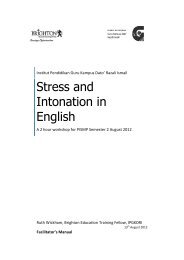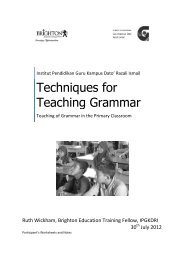Teaching English Grammar in Malaysian Primary Schools
Teaching English Grammar in Malaysian Primary Schools
Teaching English Grammar in Malaysian Primary Schools
You also want an ePaper? Increase the reach of your titles
YUMPU automatically turns print PDFs into web optimized ePapers that Google loves.
<strong>English</strong> <strong>Grammar</strong> <strong>in</strong> <strong>Malaysian</strong> <strong>Primary</strong> <strong>Schools</strong>2. Some thoughts from “Tips for <strong>English</strong>”Stephen Krashen, an expert l<strong>in</strong>guist, specialized <strong>in</strong> theories of language acquisition and developmentand has researched the area of non-<strong>English</strong> and bil<strong>in</strong>gual language acquisition.In what he orig<strong>in</strong>ally called the <strong>in</strong>put hypothesis, Krashen claims that humans acquire language onlythrough comprehensible <strong>in</strong>put.“Language acquisition does not require extensive use of conscious grammatical rules, and does notrequire tedious drill.”“Acquisition requires mean<strong>in</strong>gful <strong>in</strong>teractions <strong>in</strong> the target language – natural communication – <strong>in</strong>which speakers are concerned not with the form of their utterances but with the messages they areconvey<strong>in</strong>g and understand<strong>in</strong>g.”“The best methods are therefore those that supply ‘comprehensible <strong>in</strong>put’ <strong>in</strong> low anxiety situations,conta<strong>in</strong><strong>in</strong>g messages that students really want to hear. These methods do not force early production<strong>in</strong> the second language, but allow students to produce when they are ‘ready’, recogniz<strong>in</strong>g thatimprovement comes from supply<strong>in</strong>g communicative and comprehensible <strong>in</strong>put, and not from forc<strong>in</strong>gand correct<strong>in</strong>g production.”“In the real world, conversations with sympathetic native speakers who are will<strong>in</strong>g to help theacquirer understand are very helpful.”The Role of <strong>Grammar</strong> <strong>in</strong> Krashen’s ViewThe only <strong>in</strong>stance <strong>in</strong> which the teach<strong>in</strong>g of grammar can result <strong>in</strong> language acquisition (andproficiency) is when the student and teacher are <strong>in</strong>terested <strong>in</strong> the subject at hand and the targetlanguage is used for the explanation.Very often, both teachers and students are conv<strong>in</strong>ced that the study of formal grammar is essentialfor second language acquisition.When the skilful teacher can talk about grammar as the requirement for comprehensible <strong>in</strong>put,coupled with the students’ genu<strong>in</strong>e participation, the explanation is suitable for languageacquisition. When the affective filter is low and the learner’s conscious efforts are on the subjectmatter, the attention is on what is be<strong>in</strong>g talked about and not the medium.Teachers and learners should be careful not to deceive themselves. They can easily believe that it isthe study of grammar that is responsible for the learners’ progress. In reality, when grammar is usedas a meta-language for talk<strong>in</strong>g about grammar, progress comes from the medium and not themessage. Any subject matter that holds the learner’s <strong>in</strong>terest would do just as well.http://www.tipsforenglish.com/?p=9Ruth Wickham, Brighton Education Tra<strong>in</strong><strong>in</strong>g Fellow, IPGKDRI4
<strong>English</strong> <strong>Grammar</strong> <strong>in</strong> <strong>Malaysian</strong> <strong>Primary</strong> <strong>Schools</strong>3. Some words from “About.com”<strong>Teach<strong>in</strong>g</strong> <strong>Grammar</strong> <strong>in</strong> an ESL / EFL Sett<strong>in</strong>gOverview by Kenneth Beare, About.com Guide<strong>Teach<strong>in</strong>g</strong> grammar plays a central role <strong>in</strong> every ESL / EFL teacher's classroom. Theimportant question that needs to be answered is: how do I teach grammar? In other words,how do I help students learn the grammar they need. This question is deceptively easy. Atfirst look, you might th<strong>in</strong>k that teach<strong>in</strong>g grammar is just a matter of expla<strong>in</strong><strong>in</strong>g grammar rulesto students. However, teach<strong>in</strong>g grammar effectively is a much more complicated matter.Inductive and DeductiveInductive is known as a 'bottom up' approach. In other words, students discover grammarrules while work<strong>in</strong>g through exercises.For example:It could be a read<strong>in</strong>g comprehension which <strong>in</strong>cludes a number of sentences which describewhat a person has done up to that period <strong>in</strong> time.After do<strong>in</strong>g the read<strong>in</strong>g comprehension, the teacher could beg<strong>in</strong> to ask questions such as:‘How long has he done this or that?’ ‘Has he ever been to Paris?’ etc. and then follow with,‘When did he go to Paris?’To help the students <strong>in</strong>ductively understand the difference between the simple past and thepresent perfect, these questions could be followed with, ‘Which questions spoke about adef<strong>in</strong>ite time <strong>in</strong> the past?’ ‘Which questions asked about the person's general experience?’and so on.Deductive is known as a 'top down' approach. This is the standard teach<strong>in</strong>g approach that hasa teacher expla<strong>in</strong><strong>in</strong>g rules to the students.For example:The present perfect is made up of the auxiliary verb 'have' plus the past participle. It is used toexpress an action which has begun <strong>in</strong> the past and cont<strong>in</strong>ues <strong>in</strong>to the present moment... etc.http://esl.about.com/cs/teach<strong>in</strong>gtechnique/a/a_teachgrammar.htmRuth Wickham, Brighton Education Tra<strong>in</strong><strong>in</strong>g Fellow, IPGKDRI5
<strong>English</strong> <strong>Grammar</strong> <strong>in</strong> <strong>Malaysian</strong> <strong>Primary</strong> <strong>Schools</strong>4. Notes about “Notic<strong>in</strong>g” (excerpts from the article)<strong>Teach<strong>in</strong>g</strong> ESL Students to "Notice" <strong>Grammar</strong> (by Francis J. Noonan III)IntroductionMany teachers are confused on how to teach grammar. The form-focused <strong>in</strong>struction of the audiol<strong>in</strong>gualmethod produced students that knew a lot about a language but could not apply what theyknew to spontaneous speech. Conversely, the lack of grammar <strong>in</strong>struction <strong>in</strong> the CommunicativeApproach has often produced students who communicate well but lack grammatical competency. Isit possible to teach grammar <strong>in</strong> a way that will help students develop grammatical competency, even<strong>in</strong> spontaneous speech? This article explores a possible answer to this dilemma, the theory ofnotic<strong>in</strong>g, and its application to the classroom.Why Notic<strong>in</strong>g?The theoretical basis for notic<strong>in</strong>g centres around the relationship between explicit and implicitknowledge. Explicit knowledge is conscious knowledge of grammar rules learned through formalclassroom <strong>in</strong>struction. For example, Li knows every rule about subject-verb agreement but makesfrequent mistakes <strong>in</strong> natural speech. This knowledge is only available to him when he has time toth<strong>in</strong>k about the rules and then apply them (i.e. a grammar exercise or a writ<strong>in</strong>g assignment). Incontrast, implicit knowledge is unconscious, <strong>in</strong>ternalized knowledge of a language that is availablefor spontaneous speech. For example, Jim speaks <strong>English</strong> with near perfect use of the basic rules ofsubject-verb agreement. This is despite the fact that he may have no idea what subject-verbagreement is or what the rules are. (...)What is Notic<strong>in</strong>g?Notic<strong>in</strong>g is basically the idea that if learners pay attention to the form and mean<strong>in</strong>g of certa<strong>in</strong>language structures <strong>in</strong> <strong>in</strong>put, this will contribute to the <strong>in</strong>ternalization of the rule. (...)Remember, accord<strong>in</strong>g to this theory, the primary nature of explicit knowledge is to developawareness of rather than production of target forms.How Do Teachers Help Students Notice?How can we as teachers help students notice target forms? (...)1. Explicit <strong>in</strong>struction -- <strong>in</strong>struction expla<strong>in</strong><strong>in</strong>g and draw<strong>in</strong>g attention to a particular form.2. Frequency -- the regular occurrence of a certa<strong>in</strong> structure <strong>in</strong> <strong>in</strong>put.3. Perceptual Salience -- highlight<strong>in</strong>g or underl<strong>in</strong><strong>in</strong>g to draw attention to a certa<strong>in</strong> structure.4. Task Demands -- construct<strong>in</strong>g a task that requires learners to notice a structure <strong>in</strong> order tocomplete it.(...)Ruth Wickham, Brighton Education Tra<strong>in</strong><strong>in</strong>g Fellow, IPGKDRI6
<strong>English</strong> <strong>Grammar</strong> <strong>in</strong> <strong>Malaysian</strong> <strong>Primary</strong> <strong>Schools</strong>5. Some excerpts from ELT Methodology: Pr<strong>in</strong>ciples and Practiceby Nesamalar Chitravelu, Saratha Sithamparam, and Teh Soo Choon.What is grammar? (p196)It is possible that someone who can produce perfectly correct sentences and communicateefficiently may not be able to expla<strong>in</strong> the rules of grammar. This is true of many speakers of <strong>English</strong>,<strong>in</strong>clud<strong>in</strong>g some native speakers. Such people have implicit knowledge of grammar – they knowgrammar at the level of use. One needs to have explicit knowledge of grammar to be able todescribe and expla<strong>in</strong> the rules.The place of grammar <strong>in</strong> the communicative approach (p199)The communicative approach to language learn<strong>in</strong>g focuses on gett<strong>in</strong>g students to use language tocommunicate effectively. To achieve this, teachers usually put students <strong>in</strong>to situations where theyare us<strong>in</strong>g the language not merely <strong>in</strong> response to the teacher’s <strong>in</strong>structions, but also because theyneed it to seek <strong>in</strong>formation, give <strong>in</strong>formation, solve a problem, etc. Is there a place for the teach<strong>in</strong>gof grammar <strong>in</strong> such an approach?There are different views on this issue. At one end are teachers who prefer to teach accuracy first,that is, they beg<strong>in</strong> by teach<strong>in</strong>g grammar rules and basic sentences to equip students with a soundgrammatical base on which to develop communicative stills. At the other end are teachers whoassume that given sufficient <strong>in</strong>put and opportunities to use <strong>English</strong> <strong>in</strong> purposeful communication(through communicative activities), students will eventually acquire implicit knowledge of grammar.Teachers who use the accuracy first model will probably produce students who can reproduceaccurately sentences learnt, but it is not certa<strong>in</strong> how well these students can use these sentences <strong>in</strong>real communication. Teachers who use the communication first model are likely to producestudents who are confident and fluent <strong>in</strong> communication. It is also true that there will begrammatical errors <strong>in</strong> their language use. Students who learn <strong>English</strong> through the communicationfirst model often develop the habit of us<strong>in</strong>g ungrammatical forms. And these <strong>in</strong>accurate forms maybecome fossilised, that is, they become fixed and are extremely difficult to change. This should beavoided.Our aim <strong>in</strong> teach<strong>in</strong>g <strong>English</strong> is to develop <strong>in</strong> our students both accuracy and fluency, so that weshould <strong>in</strong>clude both types of activities: activities focuss<strong>in</strong>g on grammar, and those focuss<strong>in</strong>g onfluency. There should be a balance of both types of activities to help students improve theircommunication skills.Ruth Wickham, Brighton Education Tra<strong>in</strong><strong>in</strong>g Fellow, IPGKDRI7
<strong>English</strong> <strong>Grammar</strong> <strong>in</strong> <strong>Malaysian</strong> <strong>Primary</strong> <strong>Schools</strong>Approaches to grammar <strong>in</strong> communicative language learn<strong>in</strong>g:In covert grammar teach<strong>in</strong>g, the teacher gets the pupils <strong>in</strong>volved <strong>in</strong> us<strong>in</strong>g the structure withoutdraw<strong>in</strong>g their attention to the grammatical rules. For example, to teach the structure, ‘Do you like...?’ the teacher gets students to <strong>in</strong>terview their friends and write the names of five people who likeeach of the fruits listed <strong>in</strong> the worksheet. Students have to go round, ask<strong>in</strong>g their friends ‘Do you like...?’ <strong>in</strong> order to complete the task.The students’ attention is focussed on the activity and not the grammar rules, but they have ampleopportunity to practise the question form. It is important that the teacher ma<strong>in</strong>ta<strong>in</strong>s a warm andsupportive atmosphere so that students are not afraid to take risks to test their l<strong>in</strong>guisticcompetence. Errors should be tolerated dur<strong>in</strong>g the course of the activity. But they should also benoted down and dealt with at a later session.In overt grammar teach<strong>in</strong>g, the teacher explicitly expla<strong>in</strong>s the rules when present<strong>in</strong>g the newlanguage. Traditionally, there are two options available to the teacher. One is to use a deductiveapproach. Typically, <strong>in</strong> this approach, the teacher presents the rules / patterns / generalisations andthen goes on to provide practise <strong>in</strong> the application of these rules.The other approach is the <strong>in</strong>ductive approach or discovery method where the students are firstgiven a number of sample sentences conta<strong>in</strong><strong>in</strong>g the target forms and then the teacher guides thestudents <strong>in</strong>to deriv<strong>in</strong>g the rule for themselves.Ideally, these two approaches should not be seen as separate, but rather as complementary. agrammar rule presented covertly via a text or communicative activity can be supported by an explicitexplanation to enable students to understand the rule. A grammar rule presented overtly orexplicitly should be supported by activities which encourage students to use the structures forcommunicative purposes. The ma<strong>in</strong> aim of teach<strong>in</strong>g grammar is to help our students use <strong>English</strong>correctly <strong>in</strong> all forms of communication.Ruth Wickham, Brighton Education Tra<strong>in</strong><strong>in</strong>g Fellow, IPGKDRI8
<strong>English</strong> <strong>Grammar</strong> <strong>in</strong> <strong>Malaysian</strong> <strong>Primary</strong> <strong>Schools</strong>Your Notes:Answer the follow<strong>in</strong>g from your read<strong>in</strong>g, your discussions, and your experience:Does learn<strong>in</strong>g “<strong>Grammar</strong>” help students to learn <strong>English</strong>?........................................................................................................................................................................................................................................................................................................................................................................................................................................................................................................................................................................................................................In general terms, what is the best way to teach / learn <strong>Grammar</strong>?........................................................................................................................................................................................................................................................................................................................................................................................................................................................................................................................................................................................................................Can <strong>Grammar</strong> be ‘fun’? / Should <strong>Grammar</strong> be ‘fun’? Why / why not?........................................................................................................................................................................................................................................................................................................................................................................................................................................................................................................................................................................................................................Briefly expla<strong>in</strong> these terms:‘accuracy first’ .............................................................................................................................‘communication first’ ..................................................................................................................‘covert grammar teach<strong>in</strong>g’...........................................................................................................‘overt grammar teach<strong>in</strong>g’ ............................................................................................................‘deductive approach’ .........................................................................................................................................................................................................................................................................‘<strong>in</strong>ductive / discovery approach’........................................................................................................................................................................................................................................................Ruth Wickham, Brighton Education Tra<strong>in</strong><strong>in</strong>g Fellow, IPGKDRI9
<strong>English</strong> <strong>Grammar</strong> <strong>in</strong> <strong>Malaysian</strong> <strong>Primary</strong> <strong>Schools</strong>Discuss, and briefly describe how you could teach the simple present tense of the verb ‘to walk’ to ayear 3 class us<strong>in</strong>g:a deductive approach ..............................................................................................................................................................................................................................................................................................................................................................................................................................................................................................................................................................................................................................................................................................................................................................................................................................................................................................................................................................................................................................................................................................................................................................................................................................................................................................................................................................................................................................................................................................................................................................................................................................................................................an <strong>in</strong>ductive / discovery approach ..........................................................................................................................................................................................................................................................................................................................................................................................................................................................................................................................................................................................................................................................................................................................................................................................................................................................................................................................................................................................................................................................................................................................................................................................................................................................................................................................................................................................................................................................................................................................................................................................................................................................................................................................................................................................................................................................................................................................................................................................................................................................................................................................Ruth Wickham, Brighton Education Tra<strong>in</strong><strong>in</strong>g Fellow, IPGKDRI10
<strong>English</strong> <strong>Grammar</strong> <strong>in</strong> <strong>Malaysian</strong> <strong>Primary</strong> <strong>Schools</strong><strong>Teach<strong>in</strong>g</strong> <strong>English</strong> <strong>Grammar</strong> to Young LearnersFour Basic Pr<strong>in</strong>ciples:1. FunChildren learn much better if they are hav<strong>in</strong>gfun.2. Involve as many senses as possibleLearn<strong>in</strong>g is reta<strong>in</strong>ed better with moreconnections that are made through movement, sound, sight, smell, touch and even taste.Both physical activity and <strong>in</strong>teraction with others also assist <strong>in</strong> memory retention.3. Start with what the students know<strong>Teach<strong>in</strong>g</strong> needs to move from the known to the unknown, learn<strong>in</strong>g must start from what thestudents already know.4. FunIt is really important for the students to be hav<strong>in</strong>g fun.(In fact, older learners also learn better if they can ‘have fun’ and be engaged with the subjectmatter.)Ruth Wickham, Brighton Education Tra<strong>in</strong><strong>in</strong>g Fellow, IPGKDRI11
<strong>English</strong> <strong>Grammar</strong> <strong>in</strong> <strong>Malaysian</strong> <strong>Primary</strong> <strong>Schools</strong>Us<strong>in</strong>g Chants, Raps and Rhymes for Drill<strong>in</strong>gWhy use chants, raps and rhymes?‣ Fun – young students will be more motivated and enthusiastic‣ Intonation – students will acquire natural <strong>in</strong>tonation as they learn grammar patterns‣ Context – the grammar concepts can better be taught <strong>in</strong> a context‣ Memory – material that is learnt as a song or rhythm is better remembered.There are essentially 3 different types of chant, all of which are useful for teach<strong>in</strong>g grammar:Vocabulary ChantThe vocabulary chant teaches more than just vocabulary. Students learn vocabulary items <strong>in</strong> groupsor categories such as parts of speech, or countable and uncountable nouns.Creat<strong>in</strong>g a Vocabulary Chant1. Choose a theme, such as:1. Choose your themeFor example:School food animals occupations sport transport musicRuth Wickham, Brighton Education Tra<strong>in</strong><strong>in</strong>g Fellow, IPGKDRI12
<strong>English</strong> <strong>Grammar</strong> <strong>in</strong> <strong>Malaysian</strong> <strong>Primary</strong> <strong>Schools</strong>2. Choose 10-15 words <strong>in</strong> your theme:For example:Monkey zebra elephant crocodile rh<strong>in</strong>o / rh<strong>in</strong>ocerosSnake bear kangaroo lion3. Count the syllables <strong>in</strong> each2 2332/44Monkey zebra elephant crocodile rh<strong>in</strong>o / rh<strong>in</strong>oceros1132Snake bear kangaroo lionChoose a 2, 3, 1.zebracrocodilesnakeRuth Wickham, Brighton Education Tra<strong>in</strong><strong>in</strong>g Fellow, IPGKDRI13
<strong>English</strong> <strong>Grammar</strong> <strong>in</strong> <strong>Malaysian</strong> <strong>Primary</strong> <strong>Schools</strong>And say your chant:Zebra, Crocodile, Snake *Zebra, Crocodile, Snake *Zebra,Zebra,Crocodile,Crocodile,Zebra, Crocodile, Snake ** When you say your chant, keep a strong 4-beat rhythm by putt<strong>in</strong>g one beat on each word and thenadd<strong>in</strong>g a *click at the end of the 1 st 2 nd and last l<strong>in</strong>es.Ruth Wickham, Brighton Education Tra<strong>in</strong><strong>in</strong>g Fellow, IPGKDRI14
<strong>English</strong> <strong>Grammar</strong> <strong>in</strong> <strong>Malaysian</strong> <strong>Primary</strong> <strong>Schools</strong>ACTIVITY:Create a Vocabulary ChantBra<strong>in</strong>storm a list of names for occupations, count the number of syllables <strong>in</strong> each:occupation syllables occupation syllablesteacher 2chef 1Select a 2-syllable word, a 3-syllable word, and a 1-syllable word.2-syllable: ....................................................................................................................................3-syllable: ....................................................................................................................................1-syllable: ....................................................................................................................................Write your chant:.......................................................................................................................................................................................................................................................................................................................................................................................................................................................................................................................................................................................................................................................................Mark where the *beats* are (4 on each l<strong>in</strong>e).Perform your chant.Ruth Wickham, Brighton Education Tra<strong>in</strong><strong>in</strong>g Fellow, IPGKDRI15
<strong>English</strong> <strong>Grammar</strong> <strong>in</strong> <strong>Malaysian</strong> <strong>Primary</strong> <strong>Schools</strong><strong>Grammar</strong> ChantThe grammar chant is designed to demonstrate a particular grammar feature with its variations. Assuch, it will be somewhat repetitive, and it will centre on a particular po<strong>in</strong>t of grammar. This is verysimilar to the ‘old-fashioned’ idea of chant<strong>in</strong>g, for example, verb paradigmsfor example:I amyou arehe, she, it iswe areyou arethey are- with the addition of rhythm, some contextual <strong>in</strong>formation, and possibly <strong>in</strong>teraction between two ormore parties.Creat<strong>in</strong>g a <strong>Grammar</strong> Chant1. Decide on the grammar feature to be practised.for example: comparatives and superlatives.2. Create a conversation, or series of statements, to demonstrate the po<strong>in</strong>t.for example:Jimmy is tall!Sally is taller!Tom is the tallest <strong>in</strong> the class!Jimmy can reach this high shelf.Sally can reach that higher shelf.Tom can reach the highest shelf, the top shelf.These statements can be elicited from the students, and adjusted or corrected as necessary.Ruth Wickham, Brighton Education Tra<strong>in</strong><strong>in</strong>g Fellow, IPGKDRI16
<strong>English</strong> <strong>Grammar</strong> <strong>in</strong> <strong>Malaysian</strong> <strong>Primary</strong> <strong>Schools</strong>3. Note the stressed words or syllables, and create a rhythmic feel to the chant. These will be nouns,adjectives, adverbs, and important verbs.1 2Jimmy is tall!3 4Sally is taller!1 2 3 4Tom is the tallest <strong>in</strong> the class!1 2 3 4Jimmy can reach this high shelf.1 2 3 4Sally can reach that higher shelf.1 2 3 4Tom can reach the highest shelf,(1) (2) 3 4* * the top shelf.4. Add actions, and/or sounds and/or divide <strong>in</strong>to parts for 2 or more students or groups. In theabove example, the two empty beats lend themselves to a clap or click.5. Practise and perform the chant.6. Make sure the students notice the grammar po<strong>in</strong>t they are practis<strong>in</strong>g. For example, <strong>in</strong> this case,they should notice the adjective (high), comparative (higher), and superlative (the highest). Thenthere is the additional expression – the top shelf – as an alternative way of express<strong>in</strong>g thesuperlative. They should also notice the verb – can reach.7. Elicit possibilities for a substitution chant.For example:change the names (use student names),change the verb, change the adjective.Make any adjustments or corrections necessary to use the new chant.Ruth Wickham, Brighton Education Tra<strong>in</strong><strong>in</strong>g Fellow, IPGKDRI17
<strong>English</strong> <strong>Grammar</strong> <strong>in</strong> <strong>Malaysian</strong> <strong>Primary</strong> <strong>Schools</strong>First day of school! First day of school! Wake up, wake up! C'mon, first day of school!MARLINI don't wanna go to school. Five more m<strong>in</strong>utes.NEMONot you, dad. Me!MARLINOkay...huh?NEMOGet up, get up! It's time for school! It's time for school! It's time for school!It's time for school! Oh boy! Oh boy!MARLINAll right, I'm up.2. Th<strong>in</strong>k about the stress and <strong>in</strong>tonation. Mark any stressed words, and note any particularly obvious<strong>in</strong>tonation patterns.NEMOFirst day of school! First day of school! Wake up, wake up! C'mon, first day of school!MARLINI don't wanna go to school. Five more m<strong>in</strong>utes.NEMORuth Wickham, Brighton Education Tra<strong>in</strong><strong>in</strong>g Fellow, IPGKDRI19
<strong>English</strong> <strong>Grammar</strong> <strong>in</strong> <strong>Malaysian</strong> <strong>Primary</strong> <strong>Schools</strong>Not you, dad. Me!MARLINOkayNEMOGet up, get up! It's time for school! It's time for school! It's time for school!It's time for school! Oh boy! Oh boy!MARLINAll right, I'm up.(Chitravelu, Sithamparam, & Choon, 2005, p. 269)A sample of a jazz chant fairy tale “Goldilocks and the Three Bears” by Carolyn grantNarrator: One morn<strong>in</strong>g the three bears were busy gett<strong>in</strong>g ready for breakfast.Papa Bear: I’ll make the porridge.Mama Bear: I’ll pour the milk.Baby Bear: I’ll set the table.I’ll set the table.Chorus: And they did (clap, clap)And they did (clap, clap)Baby set the table.Mama poured the milk.Papa made the porridge,and they all sat down.Narrator: Who set the table?Chorus: Baby set the table.Narrator: Who poured the milk?Chorus: Mama poured the milk.Narrator: Who made the porridge?Chorus: Papa made the porridge.Ruth Wickham, Brighton Education Tra<strong>in</strong><strong>in</strong>g Fellow, IPGKDRI20
<strong>English</strong> <strong>Grammar</strong> <strong>in</strong> <strong>Malaysian</strong> <strong>Primary</strong> <strong>Schools</strong>Papa made the porridge,and they all sat down.They all sat down.They all sat down.They all sat down, and started to eat.Ruth Wickham, Brighton Education Tra<strong>in</strong><strong>in</strong>g Fellow, IPGKDRI21
<strong>English</strong> <strong>Grammar</strong> <strong>in</strong> <strong>Malaysian</strong> <strong>Primary</strong> <strong>Schools</strong>Drill<strong>in</strong>g and RevisionRepetition is an essential part of effective learn<strong>in</strong>g, but as soon as it becomes drudgery, some or allof the students will zone out, fail to learn, and simply become frustrated.Here are a number of games and activities which <strong>in</strong>volve teamwork and competition, <strong>in</strong> order toencourage students to be engaged without the anxiety of <strong>in</strong>dividual performance.1. TyphoonAdvantages:• Teamwork – at least 3 teams.• Added <strong>in</strong>terest for ‘bor<strong>in</strong>g’ revision tasks• Positive reward for effort and correct answer• Element of chance, anyth<strong>in</strong>g is possible• Endless possibilities for adaptation• Can be long or short period• Students can quickly learn to ‘run’ the game•Preparation:Whiteboard/Blackboard PreparationRuth Wickham, Brighton Education Tra<strong>in</strong><strong>in</strong>g Fellow, IPGKDRI22
<strong>English</strong> <strong>Grammar</strong> <strong>in</strong> <strong>Malaysian</strong> <strong>Primary</strong> <strong>Schools</strong>Preparation on paperPreparation – 2: Questions or examples to be practised.Play:1. Put the students <strong>in</strong>to teams – at least 3 teams.2. Each team, <strong>in</strong> turn, answers a question. If answered correctly, the team can then choose asquare (on the board).3 a) If the chosen square conta<strong>in</strong>s a number score, the score is written next to the team nameon the score board, as well as <strong>in</strong> the square on the grid.3 b) If the square conta<strong>in</strong>s: T the team chooses another team’s score to “blow away”(back to 0)S the team steals the po<strong>in</strong>ts from another team and addsthem to their own scoreD Whatever po<strong>in</strong>ts the team has are doubledSwap The team swaps score with another team4. The game cont<strong>in</strong>ues until all of the squares are used.Note: If time is runn<strong>in</strong>g short and the game is likely to be unf<strong>in</strong>ished, for the last few roundsannounce “no questions, just choose” so that the game will have an outcome.Ruth Wickham, Brighton Education Tra<strong>in</strong><strong>in</strong>g Fellow, IPGKDRI23
<strong>English</strong> <strong>Grammar</strong> <strong>in</strong> <strong>Malaysian</strong> <strong>Primary</strong> <strong>Schools</strong>2. B<strong>in</strong>goThis long time favourite keeps students of all ages engrossed and concentrat<strong>in</strong>g on the page<strong>in</strong> front of them.a) Markers:Use objects as markers, with the students plac<strong>in</strong>g them over words as they hear them and thenremov<strong>in</strong>g them to start a fresh game with the same card. (If the students mark the cards, theywill only be usable for one game.)Many th<strong>in</strong>gs can be used as markers, <strong>in</strong>clud<strong>in</strong>g counters, pieces of cardboard, or small stones.Depend<strong>in</strong>g on the age and maturity of the students, sunflower seeds are a popular option(allow<strong>in</strong>g the students to nibble on the seeds as they play, but be<strong>in</strong>g careful with the husks.)b) Game format:The most common size is 5 x 5, a total of 25 words, phrases, numbers or pictures. Howeverthe game can be varied to 4 x 4, 3 x 3, or any size that works for you. Students call “B<strong>in</strong>go!”when they have marked a full row <strong>in</strong> any direction (horizontal, vertical or diagonal).The game can be designed so that every card conta<strong>in</strong>s the same items, randomly rearranged.However, with a larger number of examples, each card only has a selection of the possibleanswers. In this case, the students can work towards “Full House”, only call<strong>in</strong>g out whentheir whole card is full.c) Us<strong>in</strong>g Clues:The game can be played with a set of words which the caller announces <strong>in</strong> random order,while the players look for the words on the card <strong>in</strong> front of them.Instead, the game can be played with the caller announc<strong>in</strong>g ‘clues’ to the words on theplayers’ cards. For example, the caller could announce specific verbs, and the players mustf<strong>in</strong>d the appropriate past participle form on their card.d) Rewards:The game can be played for prizes at the end of each round, but generally students aresufficiently thrilled just with “w<strong>in</strong>n<strong>in</strong>g” and it keeps the atmosphere friendlier (everybodyw<strong>in</strong>s) if there are no real w<strong>in</strong>ners and losers as such. When a student “w<strong>in</strong>s” a round, they canthen be put <strong>in</strong> the honoured position of caller, with the opportunity to practice their oral skills.e) Creat<strong>in</strong>g the game:There are a number of Internet sites which provide free B<strong>in</strong>go Card creators. The cards thenneed to be pr<strong>in</strong>ted directly from the Internet. One of the best is: ESLactivities.comRuth Wickham, Brighton Education Tra<strong>in</strong><strong>in</strong>g Fellow, IPGKDRI24
<strong>English</strong> <strong>Grammar</strong> <strong>in</strong> <strong>Malaysian</strong> <strong>Primary</strong> <strong>Schools</strong>3. JeopardyUse the format of the popular (American) game show as a classroom activity to practise orrevise material already covered.In the TV game, participants select a category and a difficulty level, and then give an‘answer’ to the item <strong>in</strong> the form of a question. In the next stage, “Double Jeopardy” theparticipant wagers (all or some of) the po<strong>in</strong>ts already won when they answer the question (seenotes from Wikipedia <strong>in</strong> Appendix). While it is not essential to phrase the answers this way,the skill of mak<strong>in</strong>g questions may be a worthwhile part of the game <strong>in</strong> the classroom.Preparation:a) Prepare questions under several category head<strong>in</strong>gs, and with several levels of difficulty <strong>in</strong>each category. These can be actual questions for which an answer is required, or stimulusanswers which require a question response.The questions can be written on cards with the po<strong>in</strong>ts value on the other side (upside down). Thecards are then attached to the board with the po<strong>in</strong>ts show<strong>in</strong>g, and lifted to reveal the question whenselected. Otherwise the grid with po<strong>in</strong>ts can be drawn on the board and the list of questions is thenheld by the teacher (or student) as presenter.If the game is go<strong>in</strong>g to move on to “Double Jeopardy!” then a second set of questions will berequired.b) Contestants – <strong>in</strong> a classroom sett<strong>in</strong>g the game can be played by teams rather than <strong>in</strong>dividualparticipants. The whole team could offer the response (loudest voice w<strong>in</strong>s) or there could be adelegated spokesman, or a relay system giv<strong>in</strong>g each team member an opportunity to speak.c) Draw the grid and a score card on the board, (or stick question cards onto the board – us<strong>in</strong>g ‘tack’is better than sticky tape which will leave a sticky residue on your board).You need a column for each category, and a row for each level (usually about 6). One cell isdesignated as a “Daily Double” (see below) but this does not show on the board.For example:Nouns Verbs Adjectives Adverbs100 100 100 100200 200 200 200300 300 300 300Score:Red TeamBlue TeamGreen TeamRuth Wickham, Brighton Education Tra<strong>in</strong><strong>in</strong>g Fellow, IPGKDRI25
<strong>English</strong> <strong>Grammar</strong> <strong>in</strong> <strong>Malaysian</strong> <strong>Primary</strong> <strong>Schools</strong>400 400 400 400500 500 500 500600 600 600 600d) Decide on a system for respond<strong>in</strong>g to questions:• are the ‘clues’ to be responded to with a question, or are they questions which need astraight answer?• is there a sound or signal to be used by the contestant wish<strong>in</strong>g to answer e.g. raise theirhand, r<strong>in</strong>g a bell or tap a glass), or do they answer <strong>in</strong> a given order?• is there a time limit for answer<strong>in</strong>g? After a contestant <strong>in</strong>dicates that they know the answer,is there a limit to the time they have to actually provide the answer (e.g. 5 seconds).e) Decide on special items such as ‘Daily Double’Daily Double operates on one selected cell of the game grid. Hav<strong>in</strong>g chosen a particular cell,which then turns out to be a “Daily Double”, contestants wager their present score (all orpart) aga<strong>in</strong>st the question – so that they double their score (if it is all wagered) if theiranswer is correct, or lose that many po<strong>in</strong>ts if they are <strong>in</strong>correct.f) Decide whether to play “Double Jeopardy!” <strong>in</strong> the next round.This round is played the same as the first, except that all of the scores are doubled, andthere are two “daily double” cells.Play: The designated first contestant / team selects a category and level. (This can be the first onthe left, or selected by some other means.) The teacher / student presenter asks the question related to that cell. Any of the teams /contestants may offer to answer once the question is read (unless you have chosen to havethe teams answer <strong>in</strong> turn) and it may be necessary to have someone designated to note whois first to respond.If the answer is correct the contents of the grid square is erased (or the card is removed) andthe score is listed under the team name.If there is a time limit, and the contestant does not answer <strong>in</strong> time after <strong>in</strong>dicat<strong>in</strong>g they wishto do so, then the designated score is deducted from their total.The w<strong>in</strong>n<strong>in</strong>g contestant then chooses another category and level, and the game cont<strong>in</strong>ues.If a chosen cell turns out to be the “Daily Double”, then the contestant who selected the cellhas the option to answer, and must first decide how much of their score to wager on theanswer.When all the cells have been used, the game can then move on to the next level, “DoubleJeopardy!”, if desired. A new set of (double) scores is written <strong>in</strong>to the grid, and two cells are(secretly) designated as “Daily Double”. A new set of questions is also needed.Ruth Wickham, Brighton Education Tra<strong>in</strong><strong>in</strong>g Fellow, IPGKDRI26
<strong>English</strong> <strong>Grammar</strong> <strong>in</strong> <strong>Malaysian</strong> <strong>Primary</strong> <strong>Schools</strong>Ruth Wickham, Brighton Education Tra<strong>in</strong><strong>in</strong>g Fellow, IPGKDRI27
<strong>English</strong> <strong>Grammar</strong> <strong>in</strong> <strong>Malaysian</strong> <strong>Primary</strong> <strong>Schools</strong>APPENDIX:Notes from Wikipedia about JeopardyGameplayThree contestants compete <strong>in</strong> three rounds: the Jeopardy! Round, the Double Jeopardy! Round, andthe F<strong>in</strong>al Jeopardy! Round. If there is a return<strong>in</strong>g champion, he or she occupies the leftmost lecternfrom the viewer's perspective.Jeopardy! RoundSix categories are announced, each with a column of five trivia clues (phrased <strong>in</strong> answer form), eachone <strong>in</strong>crementally valued more than the previous, ostensibly by difficulty.The contestant at the leftmost lectern from the viewer's perspective—a return<strong>in</strong>g champion, if thereis one—selects the first clue from any position on the game board, and the selected clue is revealed.The host then reads the clue, after which any of the three contestants may r<strong>in</strong>g <strong>in</strong> us<strong>in</strong>g a hand-heldsignall<strong>in</strong>g device. The first contestant to r<strong>in</strong>g <strong>in</strong> successfully, follow<strong>in</strong>g the host's read<strong>in</strong>g of the clue,must then respond <strong>in</strong> the form of a question.A correct response adds the dollar value of the clue to the contestant's score, and gives him or herthe opportunity to select the next clue from the board. An <strong>in</strong>correct response or a failure to respondwith<strong>in</strong> a five-second time limit (shown by the red lights on the contestant's lectern) deducts thedollar value of the clue from the contestant's score and gives any rema<strong>in</strong><strong>in</strong>g opponent(s) theopportunity to r<strong>in</strong>g <strong>in</strong> and respond. If none of the contestants give a correct response, the host readsthe correct response and the contestant who selected the previous clue chooses the next clue.Daily DoublesOne clue hidden on the Jeopardy! Round game board is designated a "Daily Double". Only thecontestant who selects a Daily Double may respond to its clue, and make a wager no smaller than $5on it. If the contestant has a score of less than the highest dollar value <strong>in</strong> the round, he or she maywager up to that top value; alternatively, the contestant may choose to "make it a true DailyDouble" and wager all of his or her score.R<strong>in</strong>g<strong>in</strong>g InContestants must wait until the host f<strong>in</strong>ishes read<strong>in</strong>g the clue before r<strong>in</strong>g<strong>in</strong>g <strong>in</strong>. R<strong>in</strong>g<strong>in</strong>g <strong>in</strong> before thispo<strong>in</strong>t locks the contestant out for one fourth of a second. Lights mounted around the game boardillum<strong>in</strong>ate to <strong>in</strong>dicate when contestants may r<strong>in</strong>g <strong>in</strong>, and the contestant has five seconds to offer aresponse.Phras<strong>in</strong>g and Judg<strong>in</strong>gAll responses must be phrased <strong>in</strong> the form of a question. For example, a contestant might select"Presidents for $200," and the result<strong>in</strong>g clue might be "The Father of Our Country; he didn't reallychop down a cherry tree," to which the contestant would respond "Who is George Wash<strong>in</strong>gton?"Griff<strong>in</strong> had orig<strong>in</strong>ally <strong>in</strong>tended for the phras<strong>in</strong>g to be grammatically correct (e.g., not accept<strong>in</strong>g anyRuth Wickham, Brighton Education Tra<strong>in</strong><strong>in</strong>g Fellow, IPGKDRI28
<strong>English</strong> <strong>Grammar</strong> <strong>in</strong> <strong>Malaysian</strong> <strong>Primary</strong> <strong>Schools</strong>phras<strong>in</strong>g other than "Who is…" for a person), but after f<strong>in</strong>d<strong>in</strong>g that grammatical correction slowedthe game down, he decided that the show should <strong>in</strong>stead accept any correct response that was <strong>in</strong>question form.Double Jeopardy! RoundThe second round, Double Jeopardy!, is played largely like the first round. In it, a new set ofcategories is revealed, and the value of each clue is. In addition, Double Jeopardy! has two DailyDoubles on the board <strong>in</strong>stead of one.Ruth Wickham, Brighton Education Tra<strong>in</strong><strong>in</strong>g Fellow, IPGKDRI29









